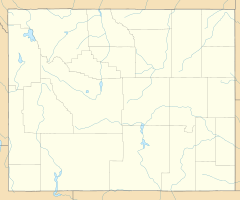Spalding Falls (Teton County, Wyoming) facts for kids
Quick facts for kids Spalding Falls |
|
|---|---|
| Lua error in Module:Infobox_mapframe at line 185: attempt to index field 'wikibase' (a nil value). | |
| Location | Grand Teton National Park, Teton County, Wyoming, United States |
| Coordinates | 43°43′43″N 110°47′49″W / 43.728542°N 110.796880°W |
| Type | Cascade |
| Elevation | 10,003 feet (3,049 m) |
| Total height | 100 feet (30 m) |
| Watercourse | Intermittent stream |
Spalding Falls is a beautiful waterfall located in Grand Teton National Park in Wyoming, USA. It's a special kind of waterfall called a cascade. This means the water tumbles down a series of rocky steps instead of a single big drop. The falls drop about 100 feet (30 meters) in total.
Spalding Falls is not always flowing. It's an "intermittent" waterfall, which means it only appears at certain times of the year. Its water comes from melting snow and ice from the Middle Teton Glacier. So, the best time to see it is usually in late spring or early summer when the snow is melting.
Contents
Discovering Spalding Falls
Spalding Falls is found deep inside Garnet Canyon. This canyon is a popular spot for hikers and climbers in Grand Teton National Park. The park itself is famous for its tall, jagged mountains and amazing wildlife.
How to Reach the Falls
To see Spalding Falls, you need to hike along the Garnet Canyon Trail. This trail is a bit challenging, but it offers incredible views of the mountains and valleys. The waterfall is about 2 miles (3.2 kilometers) further along the trail than another waterfall called Cleft Falls.
What is a Cascade Waterfall?
A cascade waterfall is different from a plunge waterfall. In a plunge waterfall, water falls straight down in one big drop. A cascade, like Spalding Falls, flows over a series of rocks and ledges. It creates a more gentle, tumbling effect as the water makes its way down the mountain.
Why the Falls are Intermittent
The water for Spalding Falls comes from snow and ice melting high up in the mountains. When the weather gets warmer, the snow melts and feeds the stream that forms the falls. As summer goes on and the snow is gone, the stream dries up. This is why the waterfall only appears for part of the year. It's a cool example of how nature works with the seasons!


